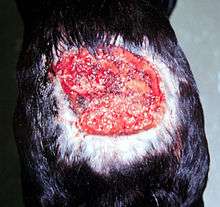Pythium insidiosum
Pythium insidiosum is a species of Pythium and a member of the class oomycota. Pythium insidiosum is mainly found in standing water and occasionally soil. Unlike most Pythium species, which are generally pathogens of terrestrial plants, Pythium insidiosum is a pathogen of mammals. It causes pythiosis,[1][2] mainly in horses, dogs, and humans. It can also cause disease in cats.[3] It is a rarely occurring, non-transmissible disease. Infection can occur in healthy mammals. The pathogen is well-adapted to mammalian body temperature, with an optimum temperature for growth of 34–36 °C (93–97 °F).
| Pythium insidiosum | |
|---|---|
 | |
| Ulcerative and destructive skin lesion in a dog caused by Pythium insidiosum | |
| Scientific classification | |
| Kingdom: | Chromista |
| Phylum: | Oomycota |
| Order: | Peronosporales |
| Family: | Pythiaceae |
| Genus: | Pythium |
| Species: | P. insidiosum |
| Binomial name | |
| Pythium insidiosum De Cock, L.Mend., A.A.Padhye, Ajello & Kaufman | |
The cell walls of Pythium insidiosum are composed of β-glucans (compared to the chitin walls of fungi), and their cytoplasmic membranes lack sterols.
References
- Schurko AM, Mendoza L, Lévesque CA, Désaulniers NL, de Cock AW, Klassen GR (May 2003). "A molecular phylogeny of Pythium insidiosum". Mycol. Res. 107 (Pt 5): 537–44. doi:10.1017/S0953756203007718. PMID 12884950.
- Krajaejun T, Imkhieo S, Intaramat A, Ratanabanangkoon K (February 2009). "Development of an Immunochromatographic Test for Rapid Serodiagnosis of Human Pythiosis". Clin. Vaccine Immunol. 16 (4): 506–9. doi:10.1128/CVI.00276-08. PMC 2668273. PMID 19225072.
- "Oomycosis". The Merck Veterinary Manual. Retrieved 2019-06-17.
This article is issued from Wikipedia. The text is licensed under Creative Commons - Attribution - Sharealike. Additional terms may apply for the media files.